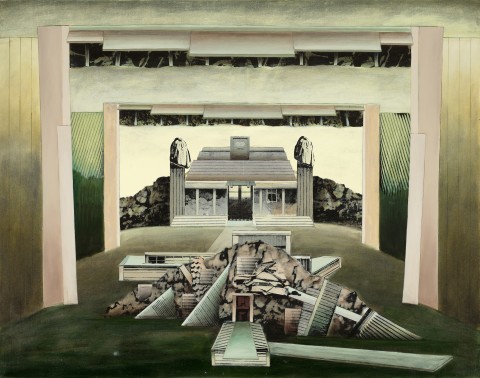THE GATE BEYOND THE GATE, 1976
JAN SENBERGS
oil and silkscreen on canvas
151.5 x 192.5 cm
Probably: Rudy Komon Gallery, Sydney
Tolarno Galleries, Melbourne
The National Australia Bank Art Collection, acquired from the above in 1977 (label attached verso)
Possibly: Jan Senbergs, Paintings, Rudy Komon Gallery, Sydney, 18 September – 13 October 1976
The Seventies: Australian Paintings and Tapestries from the Collection of National Australia Bank, National Gallery of Victoria, Melbourne, 15 October – 28 November 1982
Jan Senbergs' Survey, Heide Museum of Modern Art, Melbourne, 1 August - 18 September 1994
Lindsay, R., The Seventies: Australian Paintings and Tapestries from the Collection of National Australia Bank, The National Bank of Australasia, Melbourne, 1982, pl. 80, pp. 93 (illus.), 125
McCaughey, P., Voyage and Landfall: The Art of Jan Senbergs, The Miegunyah Press, Melbourne, 2006, pp. 46, 47 - 48 (illus.), 49
Wallace-Crabbe, C., ‘Review: Patrick McCaughey, Voyage and Landfall: The Art of Jan Senbergs’ in Australian and New Zealand Journal of Art, vol. 7, no. 2, 2006, p. 85
Kolenberg, H., Jan Senbergs Complete Screenprints 1960 – 88, Art Gallery of New South Wales, Sydney, 2008, p. 62
Gateway, 1975, colour screenprint, 50.8 x 84.0 cm, in the collection of the Art Gallery of New South Wales, Sydney
‘The Gate Beyond the Gate, 1976 was painted while Jan Senbergs was living in Canberra on an Australian University Creative Art Fellowship from 1975 to 1976. His works of this period are characterised by a general lightening of colours, with the introduction of earth colours and green to offset the sombre blacks of his earlier works. From the mid 1960s, Senbergs began incorporating photo-stencil silkscreen painted images directly onto his canvases; to enhance their clarity he used predominantly dark contrasting colours like black or dark brown. The images of his 1970s works, like the abstract shapes of his earlier works, were chosen for their formal visual qualities often from his photography or printmaking, their source being magazines, newspapers or enlarged photographic segments of objects in his studio such as worn clothing or chairs. These elements were then constructed into surrealist landscapes which, because of the fragmented quality of the imagery, are often taken as symbols of destruction with the dark palette having connotations of pessimism. They are often interpreted as a vision pf apocalyptic doom and the destruction of civilisation, although they are principally intended by the artist to be visual formalist statements. Many of his paintings of this period tend to have a central path leading back into the picture as if representing a metamorphic journey into the past for he incorporates direct architectural references into his Canberra works, recording through buildings, rather than people, the progression of time.’1
1. Lindsay, R., The Seventies: Australian paintings and tapestries from the collection of National Australia Bank, National Bank of Australasia, Melbourne, 1982, p. 93
